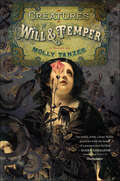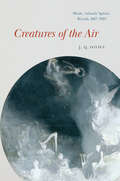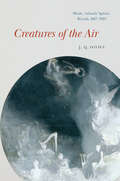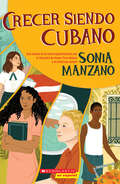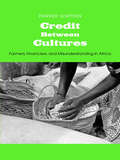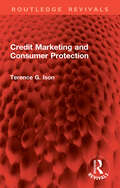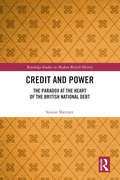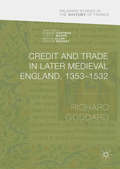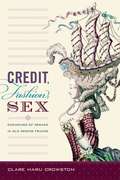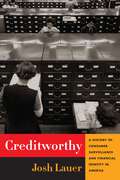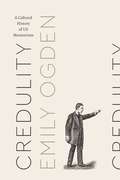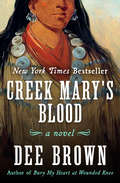- Table View
- List View
Creatures of Jurisprudence: Bears and Bees as Juridical Species
by Edward MussawirTo what extent can an animal constitute a ‘juridical species’? This highly original book considers how animals have been integral to law and to legal thinking.Going beyond the traditional approaches to animal rights and the question of whether non-human animals may be considered legal ‘subjects,’ this book follows two types of animal – bears and bees – and asks what existence these species have maintained in juridical thought. Uncovering surprising roles that the animals play in the imagination of and solution to jurisprudential problems, the book offers a counter-argument to the view that juridical thought reduces one’s appreciation for the singularity and independence of their lives. It shows, rather, that the animals exert a remarkable influence on the creative dimensions of law, offering a liveliness to it that is worthy of close attention.Contributing to new directions at the intersection of jurisprudence and human–animal studies, this book will appeal to those with interests in either of these areas.
Creatures of Want & Ruin: A Novel (The\diabolist's Library #2)
by Molly Tanzer“Profound and enthralling. This book is a delicate dream, mixing its own internal mythology with a brutal tale of prejudice and human frailty. I can’t recommend it enough. Tanzer is absolutely one to watch.” — Seanan McGuire, bestselling, award-winning author of In an Absent DreamAmityville baywoman Ellie West fishes by day and bootlegs moonshine by night. It’s dangerous work under Prohibition—independent operators like her are despised by federal agents and mobsters alike—but Ellie’s brother was accepted to college and Ellie’s desperate to see him go. So desperate that when wealthy strangers ask her to procure libations for an extravagant party Ellie sells them everything she has, including some booze she acquired under unusual circumstances.What Ellie doesn’t know is that this booze is special. Distilled from foul mushrooms by a cult of diabolists, those who drink it see terrible things—like the destruction of Long Island in fire and flood. The cult is masquerading as a church promising salvation through temperance and a return to “the good old days,” so it’s hard for Ellie to take a stand against them, especially when her father joins, but Ellie loves Long Island, and she loves her family, and she’ll do whatever it takes to ensure neither is torn apart.
Creatures of Will & Temper: A Novel (The Diabolist's Library #1)
by Molly Tanzer“A delightful, dark, and entertaining romp . . . Molly Tanzer is at the top of her form in this beautifully constructed novel.” — Jeff VanderMeer, best-selling author of the Southern Reach trilogyVictorian London is a place of fluid social roles, vibrant arts culture, fin-de-siècle wonders . . . and dangerous underground diabolic cults. Fencer Evadne Gray cares for none of the former and knows nothing of the latter when she’s sent to London to chaperone her younger sister, aspiring art critic Dorina.At loose ends after Dorina becomes enamored with their uncle’s friend, Lady Henrietta “Henry” Wotton, a local aristocrat and aesthete, Evadne enrolls in a fencing school. There, she meets George Cantrell, an experienced fencing master like she’s always dreamed of studying under. But soon, George shows her something more than fancy footwork—he reveals to Evadne a secret, hidden world of devilish demons and their obedient servants. George has dedicated himself to eradicating demons and diabolists alike, and now he needs Evadne’s help. But as she learns more, Evadne begins to believe that Lady Henry might actually be a diabolist . . . and even worse, she suspects Dorina might have become one too.Combining swordplay, the supernatural, and Victorian high society, Creatures of Will and Temper reveals a familiar but strange London in a riff on Oscar Wilde’s The Picture of Dorian Gray that readers won't soon forget.“An artful, witty, Oscar Wilde pastiche with the heart of a paranormal thriller.” — Diana Gabaldon, best-selling author of Outlander
Creatures of the Air: Music, Atlantic Spirits, Breath, 1817–1913
by J.Q. DaviesAn account of nineteenth-century music in Atlantic worlds told through the history of the art’s elemental medium, the air. Often experienced as universal and incorporeal, music seems an innocent art form. The air, the very medium by which music constitutes itself, shares with music a claim to invisibility. In Creatures of the Air, J. Q. Davies interrogates these claims, tracing the history of music’s elemental media system in nineteenth-century Atlantic worlds. He posits that air is a poetic domain, and music is an art of that domain. From West Central African ngombi harps to the European J. S. Bach revival, music expressed elemental truths in the nineteenth century. Creatures of the Air tells these truths through stories about suffocation and breathing, architecture and environmental design, climate strife, and racial turmoil. Contributing to elemental media studies, the energy humanities, and colonial histories, Davies shows how music, no longer just an innocent luxury, is implicated in the struggle for control over air as a precious natural resource. What emerges is a complex political ecology of the global nineteenth century and beyond.
Creatures of the Air: Music, Atlantic Spirits, Breath, 1817–1913 (New Material Histories of Music)
by J. Q. DaviesAn account of nineteenth-century music in Atlantic worlds told through the history of the art’s elemental medium, the air. Often experienced as universal and incorporeal, music seems an innocent art form. The air, the very medium by which music constitutes itself, shares with music a claim to invisibility. In Creatures of the Air, J. Q. Davies interrogates these claims, tracing the history of music’s elemental media system in nineteenth-century Atlantic worlds. He posits that air is a poetic domain, and music is an art of that domain. From West Central African ngombi harps to the European J. S. Bach revival, music expressed elemental truths in the nineteenth century. Creatures of the Air tells these truths through stories about suffocation and breathing, architecture and environmental design, climate strife, and racial turmoil. Contributing to elemental media studies, the energy humanities, and colonial histories, Davies shows how music, no longer just an innocent luxury, is implicated in the struggle for control over air as a precious natural resource. What emerges is a complex political ecology of the global nineteenth century and beyond.
Crecer a golpes
by Diego FonsecaEL 11 DE SEPTIEMBRE DE 1973, UNA DE LAS DICTADURAS MÁS SANGUINARIAS SE INSTALA EN CHILE PARA CAMBIAR LA FAZ DE UNA NACIÓN Y LA HISTORIA DE UN CONTINENTE Crecer a golpes recupera el ensayo y la crónica de trece reconocidos narradores y periodistas para exhibir los conflictos irresueltos que cortan la carne hasta el hueso de América Latina. La mitad de los últimos cuarenta años, América Latina albergó gobiernos ruines y coleccionó crisis como mundiales de fútbol. Para el momento en que se acabaron las tablas del ajedrez de la Guerra Fría, América Latina había atravesado dictaduras despiadadas, sobrevivido a una década adicional de cataclismos económicos y comprado los descubrimientos de la apertura económica que traían los Melquíades neoliberales. Estas historias lo embarcarán en un viaje de sur a norte por grandes y pequeñas derrotas y victorias, y por los decisivos conflictos que marcan la vida de millones de personas. En ese recorrido descubrirá el por qué de la América Latina de hoy: muchas veces, la historia puede hacer lo que desee con nosotros.
Crecer siendo cubano (Coming Up Cuban)
by Sonia ManzanoFrom Pura Belpré Honoree and Emmy-award winning actor Sonia Manzano--best known as "Maria" from Sesame Street--comes the expansive and timeless story of four children who must carve out a path for themselves in the wake of Fidel Castro's rise to power.En vísperas de un cambio de régimen en Cuba, Ana, Miguel, Zulema y Juan encuentran su lugar en un mundo que ha cambiado para siempre. Vemos los duraderos efectos de una revolución en La Habana, en el campo, en Miami y en Nueva York, en medio de un tórrido momento histórico. A través de estas historias cortas se nos recuerda que al margen de los tiempos que nos toquen vivir, todos estamos conectados para siempre en nuestra humanidad.In the wake of a new regime in Cuba, Ana, Miguel, Zulema, and Juan learn to find a place for themselves in a world forever changed. In a tumultuous moment of history, we see the lasting effects of a revolution in Havana, the countryside, Miami, and New York. Through these snapshot stories, we are reminded that regardless of any tumultuous times, we are all forever connected in our humanity.
Credibility in Elizabethan and Early Stuart Military News (Political and Popular Culture in the Early Modern Period #1)
by David RandallElizabethan and early Stuart England saw the prevailing medium for transmitting military news shift from public ritual, through private letters, to public newspapers. This study is based on an examination of hundreds of manuscript news letters, printed pamphlets and corantos, and news diaries which are in holdings in the US and the UK.
Credit Between Cultures: Farmers, Financiers, and Misunderstanding in Africa
by Parker ShiptonParker Shipton brings a variety of perspectives--cultural, economic, political, and religious-philosophical--and years of field experience to this fascinating study about people who borrow and lend in the interior of Africa. His conclusions challenge the conventional wisdom of the past half century (including perennial World Bank orthodoxy) about the need for credit among African farming people.
Credit Conditions and Recoveries from Recessions Associated with Financial Crises
by Prakash KannanA report from the International Monetary Fund.
Credit Marketing and Consumer Protection (Routledge Revivals)
by Terence G. IsonThe mid-20th century saw a significant expansion in the purchase of consumer goods and in the use of credit. At the same time, several changes in the nature of consumer credit took place. Credit cards made credit more readily available for goods and services and mass production, automated selling methods and the growth of consumer credit brought advantages. But they have also provided opportunities for predatory practices and deception. Originally published in 1979, and based on surveys and interviews, this book presents a review of some of these developments, together with an evaluation of some of the techniques of control over abuses in the marketing of consumer goods. The book discusses the financing of consumer goods, the variables that might have causative significance in leading to satisfactory or unsatisfactory transactions, and the legal positions of the time in relation to consumer problems.
Credit Nation: Property Laws and Institutions in Early America (The Princeton Economic History of the Western World #104)
by Claire PriestHow American colonists laid the foundations of American capitalism with an economy built on creditEven before the United States became a country, laws prioritizing access to credit set colonial America apart from the rest of the world. Credit Nation examines how the drive to expand credit shaped property laws and legal institutions in the colonial and founding eras of the republic.In this major new history of early America, Claire Priest describes how the British Parliament departed from the customary ways that English law protected land and inheritance, enacting laws for the colonies that privileged creditors by defining land and slaves as commodities available to satisfy debts. Colonial governments, in turn, created local legal institutions that enabled people to further leverage their assets to obtain credit. Priest shows how loans backed with slaves as property fueled slavery from the colonial era through the Civil War, and that increased access to credit was key to the explosive growth of capitalism in nineteenth-century America.Credit Nation presents a new vision of American economic history, one where credit markets and liquidity were prioritized from the outset, where property rights and slaves became commodities for creditors' claims, and where legal institutions played a critical role in the Stamp Act crisis and other political episodes of the founding period.
Credit Networks in The Preindustrial World: A Social Network Analysis Approach (Palgrave Studies in the History of Finance)
by Elise M. Dermineur Matteo PompermaierThis open access book examines the formation and sustainability of private credit networks in past societies, gathering a global range of case studies from Europe and the Americas. The book represents a fi rst attempt to coordinate the work of different scholars working on credit networks and aims to explore the possibilities offered by social network analysis for the study of past fi nancial markets and networks. Each contribution offers new perspectives for the comprehension of past fi nancial networks, with a broad chronological and geographical scope. The chapters are arranged thematically and study both rural and urban networks, each employing a network perspective to facilitate an increased understanding of the relational dynamics of preindustrial credit transactions. This book models the various ways that SNA can be utilized by economic and fi nancial historians, as well as discusses its limitations and ways in which it can be combined with qualitative archival research. The book is of interest to a broad audience of scholars in the fi elds of economic, fi nancial and social history.
Credit and Debt in Eighteenth-Century England: An Economic History of Debtors’ Prisons (Perspectives in Economic and Social History)
by Alexander WakelamThroughout the eighteenth century hundreds of thousands of men and women were cast into prison for failing to pay their debts. This apparently illogical system where debtors were kept away from their places of work remained popular with creditors into the nineteenth century even as Britain witnessed industrialisation, market growth, and the increasing sophistication of commerce, as the debtors’ prisons proved surprisingly effective. Due to insufficient early modern currency, almost every exchange was reliant upon the use of credit based upon personal reputation rather than defined collateral, making the lives of traders inherently precarious as they struggled to extract payments based on little more than promises. This book shows how traders turned to debtors’ prisons to give those promises defined consequences, the system functioning as a tool of coercive contract enforcement rather than oppression of the poor. Credit and Debt demonstrates for the first time the fundamental contribution of debt imprisonment to the early modern economy and reveals how traders made use of existing institutions to alleviate the instabilities of commerce in the context of unprecedented market growth. This book will be of interest to scholars and researchers in economic history and early modern British history.
Credit and Power: The Paradox at the Heart of the British National Debt (Routledge Studies in Modern British History)
by Simon SherrattThis book reveals the surprising role that credit, money created ex nihilo by financiers, played in raising the British government’s war loans between 1793 and 1815. Using often overlooked contemporary objections to the National Debt a startling paradox is revealed as it is shown how the government’s ostensible creditors had, in fact, very little "real" money to lend and were instead often reliant for their own solvency upon the very government they were lending to. By following the careers of unsuccessful loan-contractors, who went bankrupt lending to the government, to the triumphant career of the House of Rothschild; who successfully "exported" the British system of war-financing abroad with the coming of peace, the symbiotic relationship that existed between the British government and their ostensible creditors is revealed. Also highlighted is the power granted to the (technically bankrupt) Bank of England over credit and the money supply, an unprecedented and highly influential development that filled many contemporaries with horror. This is a tale of bankruptcy, stock market manipulation, bribery and institutional corruption that continues to exert its influence today and will be of interest to anyone interested in government financing, debt and the origins of modern finance.
Credit and Trade in Later Medieval England, 1353-1532 (Palgrave Studies in the History of Finance)
by Richard GoddardThis book challenges the notion that economic crises aremodern phenomena through its exploration of the tumultuous 'credit-crunch' ofthe later Middle Ages. It illustrates clearly how influences such as the BlackDeath, inter-European warfare, climate change and a bullion famine occasionedsevere and prolonged economic decline across fifteenth century England. Earlychapters discuss trends in lending and borrowing, and the use of credit to funddomestic trade through detailed analysis of the Statute Staple and rich primarysources. The author then adopts a broad-based geographic lens to examineprovincial credit before focusing on London's development as the commercial powerhousein late medieval business. Academics and students of modern economic change and historicfinancial revolutions alike will see that the years from 1353 to1532 encompassed immense upheaval and change, reminiscent of modern recessions. The author carefully guides the reader to see that these shifts are theprecursors of economic change in the early modern period, laying thefoundations for the financial world as we know it today.
Credit, Currency, and Capital: The Scottish Financial Revolution, 1690-1727 (Political Economies of Capitalism, 1600-1850)
by Andrew McDiarmidThe years 1690–1727 represented a period of significant change for Scotland. It was a time of grand colonial endeavours and financial innovation, punctuated by bouts of economic turmoil and constitutional and political uncertainty. The infamous Darien Scheme, the establishment of the Bank of Scotland and the Royal Bank of Scotland, the Anglo-Scots Union, the Hanoverian Succession, and the Jacobite rising of 1715, all occurred during this short time span. Therefore, it was not only a period that presented Scotland with opportunities but also a period in which the country ultimately lost its autonomy. It was also during these years, and against this unsettled backdrop, that the Scottish Financial Revolution commenced. The complexity of the Scottish situation during the late seventeenth and the early eighteen centuries has historically made the identification of a Scottish Financial Revolution difficult. This monograph, the first dedicated to the topic, addresses this problem and provides a model for identifying and understanding the revolution through the economic, political, and constitutional contexts of the period. Using examples of financial developments and innovation driven by Scotsmen in Scotland, Europe, and the colonies, this work defines the Scottish Financial Revolution as a series of developments which took place in Scotland when political circumstances allowed, but which also occurred outwith Scotland through the agency of members of the Scottish diaspora. This monograph is therefore the story of how Scotsmen at home and abroad contributed to financial debate and development between 1690 and 1727. Credit, Currency, and Capital: The Scottish Financial Revolution, 1690–1727 will appeal to students and scholars interested in the history of Economics and Finance. It will also be of interest to those studying the history of the Anglo-Scots Union and the complex relationship between Scotland and England.
Credit, Fashion, Sex: Economies of Regard in Old Regime France
by Clare Haru CrowstonIn Old Regime France credit was both a central part of economic exchange and a crucial concept for explaining dynamics of influence and power in all spheres of life. Contemporaries used the term credit to describe reputation and the currency it provided in court politics, literary production, religion, and commerce. Moving beyond Pierre Bourdieu's theorization of capital, this book establishes credit as a key matrix through which French men and women perceived their world. As Clare Haru Crowston demonstrates, credit unveils the personal character of market transactions, the unequal yet reciprocal ties binding society, and the hidden mechanisms of political power.Credit economies constituted "economies of regard" in which reputation depended on embodied performances of credibility. Crowston explores the role of fashionable appearances and sexual desire in leveraging credit and reconstructs women's vigorous participation in its gray markets. The scandalous relationship between Queen Marie Antoinette and fashion merchant Rose Bertin epitomizes the vertical loyalties and deep social divides of the credit regime and its increasingly urgent political stakes.
Creditworthy: A History of Consumer Surveillance and Financial Identity in America (Columbia Studies in the History of U.S. Capitalism)
by Josh LauerThe first consumer credit bureaus appeared in the 1870s and quickly amassed huge archives of deeply personal information. Today, the three leading credit bureaus are among the most powerful institutions in modern life—yet we know almost nothing about them. Experian, Equifax, and TransUnion are multi-billion-dollar corporations that track our movements, spending behavior, and financial status. This data is used to predict our riskiness as borrowers and to judge our trustworthiness and value in a broad array of contexts, from insurance and marketing to employment and housing. In Creditworthy, the first comprehensive history of this crucial American institution, Josh Lauer explores the evolution of credit reporting from its nineteenth-century origins to the rise of the modern consumer data industry. By revealing the sophistication of early credit reporting networks, Creditworthy highlights the leading role that commercial surveillance has played—ahead of state surveillance systems—in monitoring the economic lives of Americans. Lauer charts how credit reporting grew from an industry that relied on personal knowledge of consumers to one that employs sophisticated algorithms to determine a person's trustworthiness. Ultimately, Lauer argues that by converting individual reputations into brief written reports—and, later, credit ratings and credit scores—credit bureaus did something more profound: they invented the modern concept of financial identity. Creditworthy reminds us that creditworthiness is never just about economic "facts." It is fundamentally concerned with—and determines—our social standing as an honest, reliable, profit-generating person.
Credulity: A Cultural History of US Mesmerism (Class 200: New Studies in Religion)
by Emily OgdenFrom the 1830s to the Civil War, Americans could be found putting each other into trances for fun and profit in parlors, on stage, and in medical consulting rooms. They were performing mesmerism. Surprisingly central to literature and culture of the period, mesmerism embraced a variety of phenomena, including mind control, spirit travel, and clairvoyance. Although it had been debunked by Benjamin Franklin in late eighteenth-century France, the practice nonetheless enjoyed a decades-long resurgence in the United States. Emily Ogden here offers the first comprehensive account of those boom years. Credulity tells the fascinating story of mesmerism’s spread from the plantations of the French Antilles to the textile factory cities of 1830s New England. As it proliferated along the Eastern seaboard, this occult movement attracted attention from Ralph Waldo Emerson’s circle and ignited the nineteenth-century equivalent of flame wars in the major newspapers. But mesmerism was not simply the last gasp of magic in modern times. Far from being magicians themselves, mesmerists claimed to provide the first rational means of manipulating the credulous human tendencies that had underwritten past superstitions. Now, rather than propping up the powers of oracles and false gods, these tendencies served modern ends such as labor supervision, education, and mediated communication. Neither an atavistic throwback nor a radical alternative, mesmerism was part and parcel of the modern. Credulity offers us a new way of understanding the place of enchantment in secularizing America.
Cree Narrative Memory: From Treaties To Contemporary Times
by Neal McLeodNeal McLeod examines the history of the nêhiyawak (Cree People) of western Canada from the massive upheavals of the 1870s and the reserve period to the vibrant cultural and political rebirth of contemporary times. Central to the text are the narratives of McLeod's family, which give first hand examples of the tenacity and resiliency of the human spirit while providing a rubric for reinterpreting the history of Indigenous people, drawing on Cree worldviews and Cree narrative structures. <p><p> In a readable style augmented with extensive use of the Cree language throughout, McLeod draws heavily on original research, the methodology of which could serve as a template for those doing similar work. While the book is based on the Cree experience of the Canadian prairies, its message and methodology are applicable to all Indigenous societies.
Creek Country
by Robbie EthridgeReconstructing the human and natural environment of the Creek Indians in frontier Georgia, Mississippi, Alabama, and Tennessee, Robbie Ethridge illuminates a time of wrenching transition. Creek Country presents a compelling portrait of a culture in crisis, of its resiliency in the face of profound change, and of the forces that pushed it into decisive, destructive conflict.Ethridge begins in 1796 with the arrival of U.S. Indian Agent Benjamin Hawkins, whose tenure among the Creeks coincided with a period of increased federal intervention in tribal affairs, growing tension between Indians and non-Indians, and pronounced strife within the tribe. In a detailed description of Creek town life, the author reveals how social structures were stretched to accommodate increased engagement with whites and blacks. The Creek economy, long linked to the outside world through the deerskin trade, had begun to fail. Ethridge details the Creeks' efforts to diversify their economy, especially through experimental farming and ranching, and the ecological crisis that ensued. Disputes within the tribe culminated in the Red Stick War, a civil war among Creeks that quickly spilled over into conflict between Indians and white settlers and was ultimately used by U.S. authorities to justify their policy of Indian removal.
Creek Internationalism in an Age of Revolution, 1763–1818 (Borderlands and Transcultural Studies)
by James L. HillCreek Internationalism in an Age of Revolution, 1763–1818 examines how Creek communities and their leaders remained viable geopolitical actors in the trans-Appalachian West well after the American Revolution. The Creeks pursued aggressive and far-reaching diplomacy between 1763 and 1818 to assert their territorial and political sovereignty while thwarting American efforts to establish control over the region. The United States and the Creeks fought to secure recognition from the powers of Europe that would guarantee political and territorial sovereignty: the Creeks fought to maintain their connections to the Atlantic world and preserve their central role in the geopolitics of the trans-Appalachian West, while the American colonies sought first to establish themselves as an independent nation, then to expand borders to secure diplomatic and commercial rights. Creeks continued to forge useful ties with agents of European empires despite American attempts to circumscribe Creek contact with the outside world. The Creeks&’ solicitation of trade and diplomatic channels with British and Spanish colonists in the West Indies, Canada, and various Gulf Coast outposts served key functions for defenders of local autonomy. Native peoples fought to preserve the geopolitical order that dominated the colonial era, making the trans-Appalachian West a kaleidoscope of sovereign peoples where negotiation prevailed. As a result, the United States lacked the ability to impose its will on its Indigenous neighbors, much like the European empires that had preceded them. Hill provides a significant revisionist history of Creek diplomacy and power that fills gaps within the broader study of the Atlantic world and early American history to show how Indigenous power thwarted European empires in North America.
Creek Mary's Blood: A Novel
by Dee BrownThe New York Times–bestselling saga of Creek Indian Mary Musgrove and her descendants, whose lives parallel the American story through two centuries. In Creek Mary&’s Blood, Dee Brown fictionalizes the astonishing true story of Mary Musgrove—born in 1700 to a Creek tribal chief—and five generations of her family. By tracing her struggles with colonists in Georgia, and then the lives of her two sons (one born to a white trader and the other to a Cherokee warrior), Brown&’s novel creates a gripping panorama of the American Indian experience in the eighteenth and nineteenth centuries. His narrative spans colonial rebellion, the Trail of Tears, and the Civil War—in which Mary&’s descendants fought on both sides of the conflict. Rich with historical detail and human drama, this is a novel filled with &“dark, inexorable energy&” by the #1 New York Times–bestselling author of Bury My Heart at Wounded Knee. This ebook features an illustrated biography of Dee Brown including rare photos from the author&’s personal collection.
Creek Paths and Federal Roads
by Angela Pulley HudsonInCreek Paths and Federal Roads, Angela Pulley Hudson offers a new understanding of the development of the American South by examining travel within and between southeastern Indian nations and the southern states, from the founding of the United States until the forced removal of southeastern Indians in the 1830s. During the early national period, Hudson explains, settlers and slaves made their way along Indian trading paths and federal post roads, deep into the heart of the Creek Indians' world. Hudson focuses particularly on the creation and mapping of boundaries between Creek Indian lands and the states that grew up around them; the development of roads, canals, and other internal improvements within these territories; and the ways that Indians, settlers, and slaves understood, contested, and collaborated on these boundaries and transit networks. While she chronicles the experiences of these travelers--Native, newcomer, free, and enslaved--who encountered one another on the roads of Creek country, Hudson also places indigenous perspectives squarely at the center of southern history, shedding new light on the contingent emergence of the American South.


